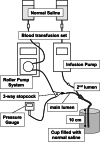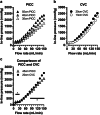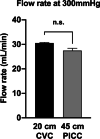A pressure-resistant peripherally inserted central catheter is as useful as a central venous catheter for rapid fluid infusion: an in vitro study
- PMID: 35787789
- PMCID: PMC9252047
- DOI: 10.1186/s12871-022-01738-x
A pressure-resistant peripherally inserted central catheter is as useful as a central venous catheter for rapid fluid infusion: an in vitro study
Abstract
Background: Although peripherally inserted central catheters (PICCs) have been widely used, they have not been frequently used in anesthesia practice. The central venous pressure measured via PICCs are reportedly as accurate as that measured via central venous catheters (CVCs), but the findings concerning rapid infusion are unclear. This study examined whether or not pressure-resistant PICCs could be used for rapid fluid infusion. METHODS: The in-line pressure was measured in similar-sized double-lumen catheters-4-Fr PICC (55, 45 and 35 cm) and 17-G CVC (20 and 13 cm)-at flow rates of saline decided using a roller pump system. We also examined the flow rate at an in-line pressure of 300 mmHg, which is the critical pressure at which hemolysis is considered to occur during blood transfusion.
Results: The pressure-resistant PICCs obtained a high flow rate similar to that of CVCs, but the in-line pressures increased in proportion to the flow rate and catheter length. Flow rates at an intra-circuit pressure of 300 mmHg were not significantly different between the 45-cm PICC and 20-cm CVC.
Conclusion: Pressure-resistant PICCs can be used for rapid fluid infusion.
Keywords: Blood transfusion; Central venous catheter (CVC); Fluid infusion; Peripherally inserted central catheter (PICC); Rapid fluid infusion.
© 2022. The Author(s).
Conflict of interest statement
There are no relevant conflicts of interest.
Figures



Similar articles
-
Comparison of microbial colonization rates between central venous catheters and peripherally inserted central catheters.Antimicrob Resist Infect Control. 2023 Aug 7;12(1):74. doi: 10.1186/s13756-023-01285-1. Antimicrob Resist Infect Control. 2023. PMID: 37550791 Free PMC article.
-
Central venous pressure measurements: peripherally inserted catheters versus centrally inserted catheters.Crit Care Med. 2000 Dec;28(12):3833-6. doi: 10.1097/00003246-200012000-00014. Crit Care Med. 2000. PMID: 11153622 Clinical Trial.
-
Peripherally inserted central catheters versus non-tunnelled ultrasound-guided central venous catheters in newborns: a retrospective observational study.BMJ Open. 2022 Apr 6;12(4):e058866. doi: 10.1136/bmjopen-2021-058866. BMJ Open. 2022. PMID: 35387831 Free PMC article.
-
Risk of catheter-related bloodstream infection with peripherally inserted central venous catheters used in hospitalized patients.Chest. 2005 Aug;128(2):489-95. doi: 10.1378/chest.128.2.489. Chest. 2005. PMID: 16100130 Review.
-
Peripherally inserted central venous catheters are not superior to central venous catheters in the acute care of surgical patients on the ward.World J Surg. 2006 Aug;30(8):1605-19. doi: 10.1007/s00268-005-0174-y. World J Surg. 2006. PMID: 16865322 Review.
Cited by
-
Application value of high-pressure-resistant peripherally inserted central catheters in enhanced computer tomography of diabetic patients with malignant tumors.World J Diabetes. 2024 Dec 15;15(12):2293-2301. doi: 10.4239/wjd.v15.i12.2293. World J Diabetes. 2024. PMID: 39676811 Free PMC article.
-
Correlation between ultrasound-measured inferior vena cava diameter and peripherally inserted central catheter measured central venous pressure in low birth weight infants.Am J Transl Res. 2025 Mar 15;17(3):2266-2275. doi: 10.62347/BMDJ4584. eCollection 2025. Am J Transl Res. 2025. PMID: 40226021 Free PMC article.
References
-
- Wagener G, Bezinover D, Wang C, Kroepfl E, Diaz G, Giordano C, West J, Kindscher JD, Moguilevitch M, Nicolau-Raducu R, et al. Fluid Management During Kidney Transplantation: A Consensus Statement of the Committee on Transplant Anesthesia of the American Society of Anesthesiologists. Transplantation. 2021;105(8):1677–1684. doi: 10.1097/TP.0000000000003581. - DOI - PubMed
Publication types
MeSH terms
LinkOut - more resources
Full Text Sources

